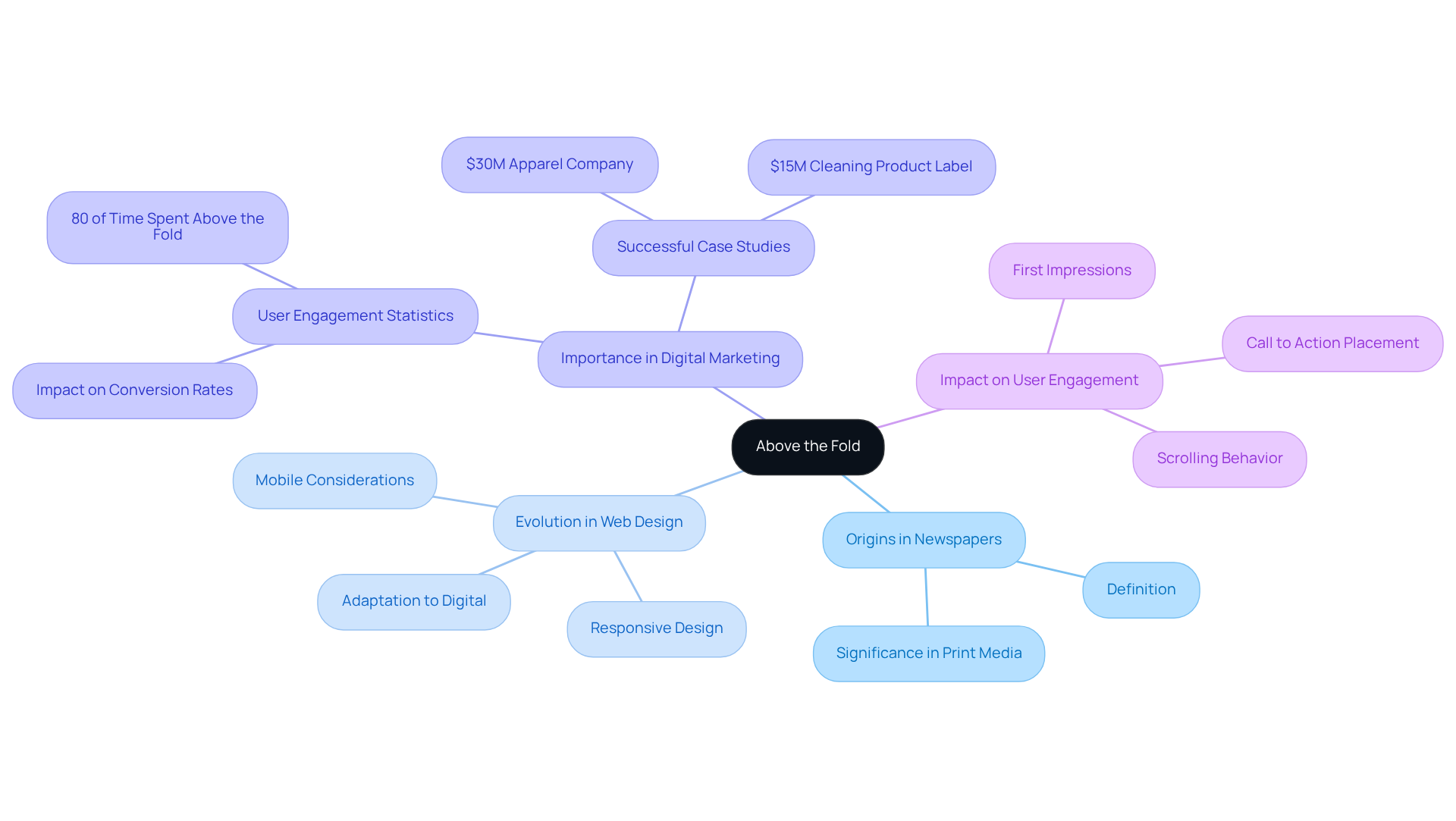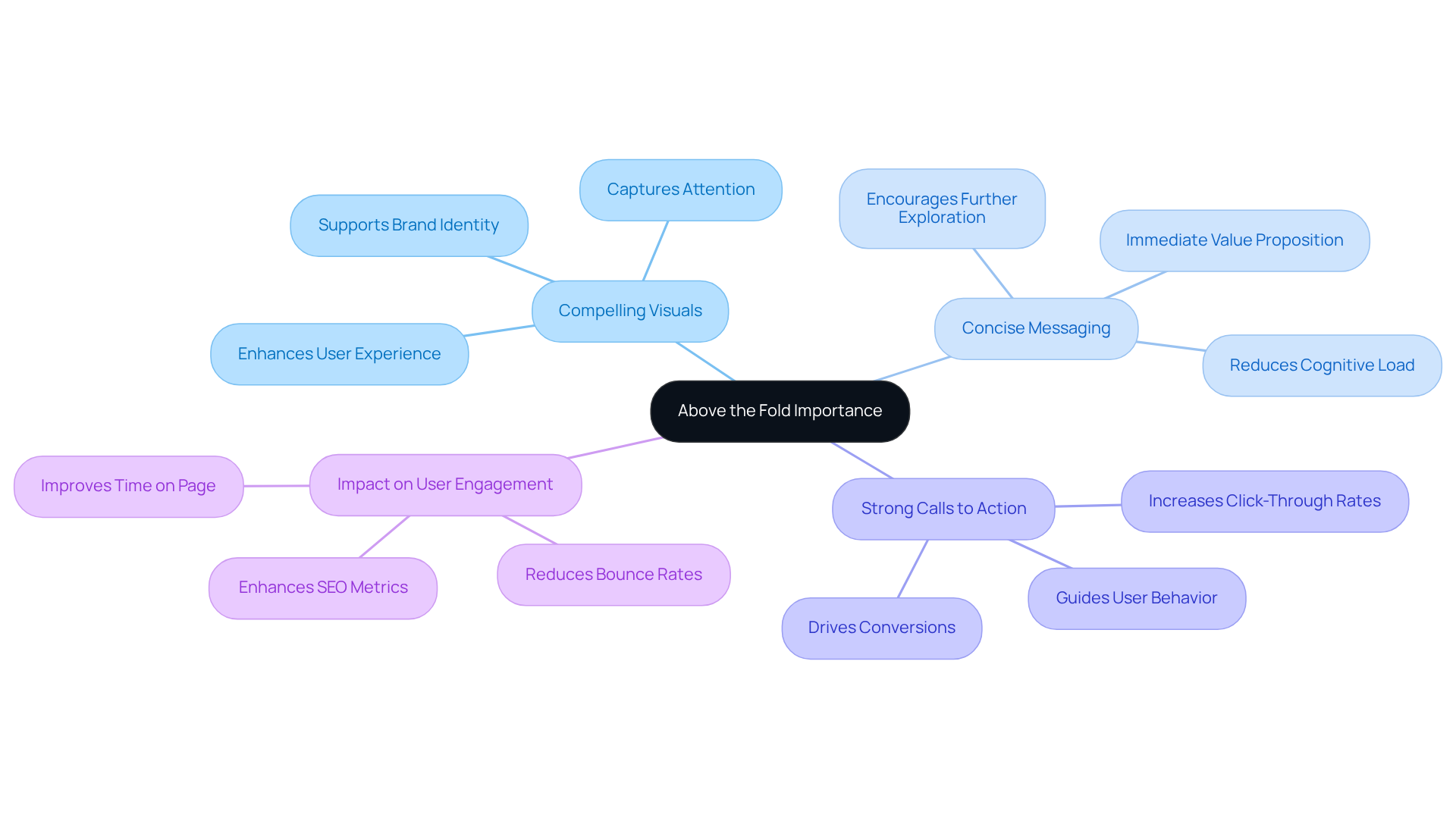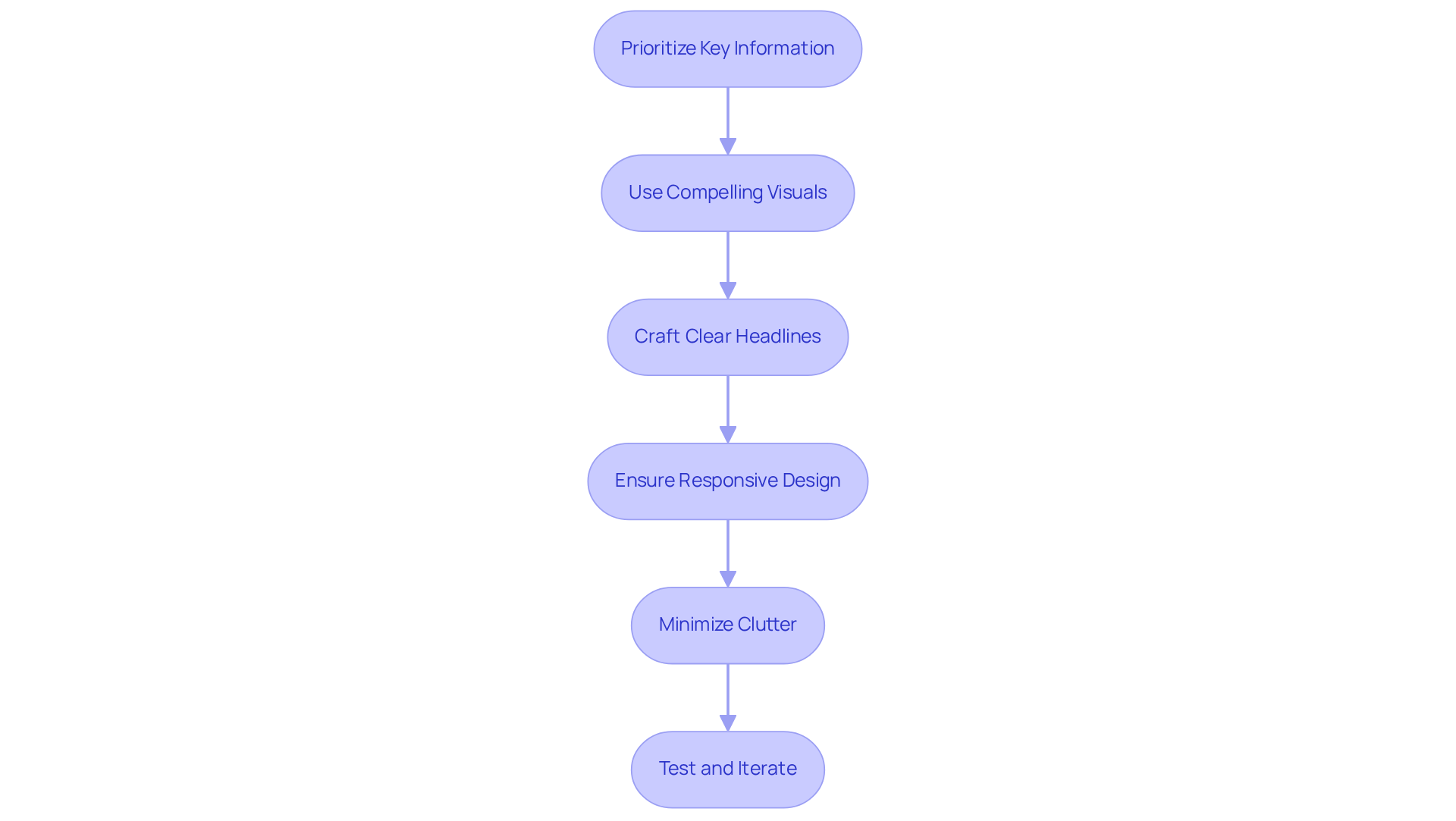
Overview
The concept of "above the fold" is paramount for the success of direct-to-consumer (DTC) brands, as it denotes the portion of a webpage visible without scrolling. This critical area significantly influences user engagement and conversion rates. To optimize this space effectively, brands must employ:
- Compelling visuals
- Clear messaging
- Strong calls to action
Such strategic enhancements can substantially elevate user interaction, reduce bounce rates, and ultimately drive higher profitability for brands.
By focusing on the optimization of this visible space, brands position themselves to capture immediate attention and foster a deeper connection with their audience. The integration of these elements not only increases engagement but also cultivates a user experience that encourages conversions. In the competitive landscape of DTC marketing, mastering the art of "above the fold" is not just beneficial; it is essential.
Introduction
The concept of "above the fold" has transcended its print origins to become a pivotal element in web design, shaping how brands engage with their audience online. This prime digital real estate not only captures initial attention but also significantly influences user interaction and conversion rates. As direct-to-consumer brands navigate an increasingly competitive landscape, understanding how to optimize this critical space becomes essential.
What strategies can be employed to ensure that the content above the fold not only attracts but retains visitor interest, ultimately driving success for brands?
Define 'Above the Fold' in Web Design
Above the fold' refers to the portion of a webpage that is immediately visible to visitors without the need for scrolling when the page first loads. This concept, originating from the print industry, describes the upper half of a folded newspaper. In web design, this section plays a crucial role in forming the initial impression visitors have of a site, typically showcasing essential elements such as headlines, images, and calls to action (CTAs).
Effective design in this area is paramount for capturing audience attention and driving engagement; research indicates that individuals spend approximately 57% of their time in areas that above the fold means. This highlights what above the fold means, emphasizing the importance of strategically positioning the most engaging content in this space to boost conversion rates.
For example, successful e-commerce websites like Pulman's visual navigation for car purchases and Procure Smart's clear location search bar leverage compelling visuals and distinct CTAs above the fold to foster immediate interaction.
Design experts, including John Hughes, note that optimizing UX design is challenging because above the fold means addressing the diverse intents and needs of visitors, making it essential to strike a balance between creativity and usability in this section. By prioritizing impactful above-the-fold content, brands significantly enhance their likelihood of converting visitors into customers, particularly as modern users increasingly prefer to scroll for information.

Explore the Origins and Evolution of 'Above the Fold'
The term 'above the fold' originates from the newspaper industry, where it denoted the most significant stories positioned on the upper half of the front page. This strategic placement was essential for capturing readers' attention and boosting sales. As the digital landscape evolved, web designers adopted this concept to illustrate what above the fold means in emphasizing the importance of the initial viewable area of a webpage. However, the definition of 'above the fold' has transformed, especially with the advent of mobile devices that feature varying screen sizes. Today, it is acknowledged as a dynamic environment that necessitates optimization for various devices and contexts of use.
Digital marketing specialists emphasize that although individuals have grown accustomed to scrolling, understanding what above the fold means is essential for creating a powerful first impression and boosting engagement. Statistics reveal that users spend approximately 80% of their time focusing on information located above the fold means that it plays a significant role in driving conversions. For instance, a $30M apparel company that collaborated with Parah Group experienced a 35% rise in conversion rates after enhancing their homepage to emphasize social proof and reviews above the fold. Likewise, a $15M cleaning product label enhanced their average order value by 80% through strategic positioning of bundles and value propositions in this key location, including gamified progress bars for free shipping limits and complimentary gifts over a certain cart size.
Consequently, contemporary design approaches should emphasize flexibility, ensuring that this prime real estate effectively conveys narratives and directs interactions across all platforms.

Understand the Importance of 'Above the Fold' for User Engagement
The section that is crucial for attracting audience involvement is what above the fold means, with research indicating that up to 80% of interactions occur within this space. Optimizing this area can lead to a substantial reduction in bounce rates; effective designs have demonstrated reductions of up to 30% in certain instances. This prime real estate must feature:
- Compelling visuals
- Concise messaging
- Strong calls to action that resonate with the target audience
For direct-to-consumer companies, understanding what above the fold means is crucial, as a well-crafted section acts as a gateway to deeper engagement, directly influencing conversion rates. By captivating individuals and fostering a positive atmosphere for their overall experience, this space plays a pivotal role in guiding visitors toward exploring the brand's offerings.

Implement Best Practices for Above-the-Fold Optimization
To optimize above-the-fold content effectively, several best practices should be considered:
- Prioritize Key Information: Position essential elements such as value propositions and calls to action prominently in this area to capture immediate attention.
- Use Compelling Visuals: Incorporate high-quality images or videos that not only attract attention but also convey messages succinctly, enhancing audience engagement.
- Craft Clear Headlines: Headlines must be concise and engaging, clearly articulating the brand's value to encourage further exploration.
- Ensure Responsive Design: Given the diversity of screen sizes, it is crucial to optimize above-the-fold content for both desktop and mobile views, ensuring a seamless experience across devices.
- Minimize Clutter: Avoid overcrowding this space with excessive information; instead, focus on clarity and simplicity to facilitate quick comprehension.
- Test and Iterate: Utilize A/B testing as a component of a thorough CRO strategy to determine which elements connect best with individuals. This data-focused method enables modifications that improve interaction and conversions, ultimately maximizing profitability.
By applying these strategies, DTC companies can significantly enhance what above the fold means for their effectiveness, resulting in improved experiences for visitors and increased profitability. Given that CRO often yields a higher ROI compared to traditional ad spend, these practices not only enhance user engagement but also contribute to long-term financial success. Leveraging our agency's extensive experience in both brand and agency settings, we ensure a holistic approach that aligns your paid ads and landing pages, driving significant growth.

Conclusion
The concept of 'above the fold' is crucial in determining the success of direct-to-consumer brands, as it shapes the initial user experience on their websites. This vital area, visible without scrolling, serves as the first point of contact for visitors, making it essential for brands to optimize this space effectively. By strategically placing engaging visuals, concise messaging, and compelling calls to action in this section, brands can significantly enhance user interaction and drive conversion rates.
Key insights throughout the article highlight the historical origins of the term from the print industry and its evolution in the digital landscape. The emphasis on user engagement reveals that up to 80% of interactions occur above the fold, underscoring the necessity for brands to focus on this area to reduce bounce rates and foster deeper connections with potential customers. Best practices such as:
- Prioritizing key information
- Utilizing high-quality visuals
- Ensuring responsive design
are essential strategies that can lead to substantial improvements in user experience and profitability.
Ultimately, optimizing above-the-fold content not only enhances user engagement but also contributes to the long-term financial success of DTC brands. As the digital marketplace continues to evolve, prioritizing this prime real estate can set brands apart in a competitive landscape. By implementing the discussed strategies, companies can create a powerful first impression that resonates with visitors and encourages them to explore further, thereby unlocking their full potential for growth and success.
Frequently Asked Questions
What does 'above the fold' mean in web design?
'Above the fold' refers to the portion of a webpage that is immediately visible to visitors without scrolling when the page first loads.
Where does the term 'above the fold' originate?
The term originates from the print industry, describing the upper half of a folded newspaper.
Why is the 'above the fold' section important in web design?
This section is crucial for forming the initial impression visitors have of a site and typically showcases essential elements such as headlines, images, and calls to action (CTAs).
How much time do visitors spend on content above the fold?
Research indicates that individuals spend approximately 57% of their time on areas that are above the fold.
Can you provide examples of effective 'above the fold' design?
Successful e-commerce websites like Pulman's visual navigation for car purchases and Procure Smart's clear location search bar effectively use compelling visuals and distinct CTAs above the fold to encourage immediate interaction.
What challenges do designers face when optimizing 'above the fold' content?
Designers must address the diverse intents and needs of visitors, making it essential to balance creativity and usability in this section.
How can brands benefit from prioritizing impactful 'above the fold' content?
By focusing on effective above-the-fold content, brands can significantly enhance their likelihood of converting visitors into customers, especially as modern users increasingly prefer to scroll for information.
FAQs











